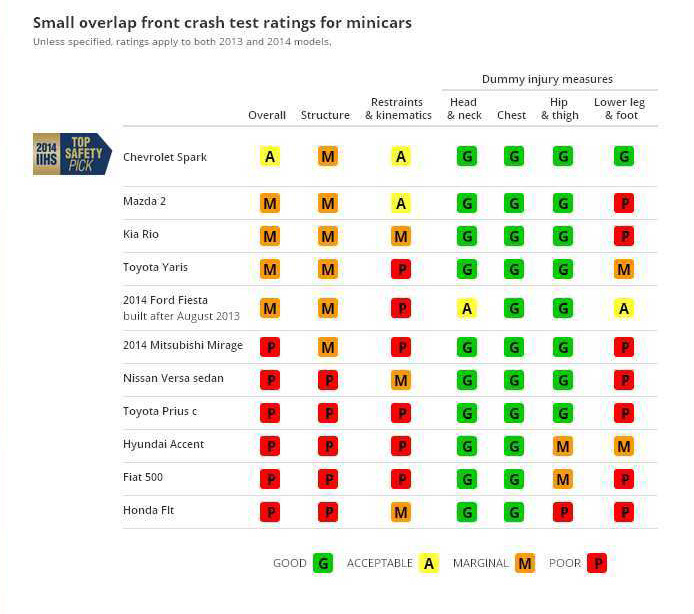ARLINGTON, Va. — Only 1 minicar out of 11 tested achieves an acceptable rating in the Insurance Institute for Highway Safety’s small overlap front crash test, making these tiny vehicles the worst performing group of any evaluated so far.
The Chevrolet Spark’s acceptable rating in the test, along with good ratings in the Institute’s four other crashworthiness evaluations, earns the new minicar a 2014 TOP SAFETY PICK award. The Spark was among the initial award winners announced in December. The new small overlap test results for the rest of the minicar group mean that no other models in this size category join the Spark in the winner’s circle yet.
Introduced in 2012, the small overlap test replicates what happens when the front corner of a vehicle collides with another vehicle or an object such as a tree or utility pole. In the test, 25 percent of a vehicle’s front end on the driver’s side strikes a rigid barrier at 40 mph.
The test is more difficult than the head-on crashes conducted by the government or the longstanding IIHS moderate overlap test because most of the vehicle’s front-end crush zone is bypassed. That makes it hard for the vehicle to manage crash energy, and the occupant compartment can collapse as a result. Nevertheless, in many size categories, manufacturers have found ways to improve vehicle structures to meet this challenge.
“Small, lightweight vehicles have an inherent safety disadvantage. That’s why it’s even more important to choose one with the best occupant protection,” says Joe Nolan, IIHS senior vice president for vehicle research. “Unfortunately, as a group, minicars aren’t performing as well as other vehicle categories in the small overlap crash.”
In contrast to the minicar group’s performance, most models in the small car category, which are a little larger, have done much better in the test. There are five good ratings and five acceptable ratings among 17 small cars that have been evaluated so far.
Looking at the component ratings that make up the overall marks, every minicar, including the Spark, rates marginal or poor for structure, the most fundamental element of occupant protection. When a vehicle’s structure doesn’t hold up, injury risk is high. Collapsing structures can knock frontal airbags and seats out of position, exacerbating the problem.
All the vehicles except the Spark and the Mazda 2 also earn low ratings for restraints and kinematics. Seven of the 11 were downgraded for allowing too much occupant forward motion during the crash. In these cases, either the safety belt didn’t do a good enough job holding the dummy in place, or the dummy’s head missed or slid off the frontal airbag. The side curtain airbag, which has an important role to play in small overlap frontal crashes, provided insufficient forward coverage in eight of the minicars and didn’t deploy at all in the Toyota Yaris. In many models, the steering column moved sideways, and in three cars the seat tipped.
The two worst performers are the Honda Fit and the Fiat 500. In both cases, intruding structure seriously compromised the driver’s space, and the steering column was pushed back toward the driver. In the case of the Fit, the dummy’s head barely contacted the frontal airbag before sliding off and hitting the instrument panel. During the test of the 500, the driver door opened after the hinges tore. An open door creates a risk that the driver could be partially or completely ejected.
Injury measures on the dummy’s left legs are marginal or poor for many models. In most cases, potential injuries involved the lower leg, but the Fit, 500 and Hyundai Accent were downgraded for left thigh or hip injury. The Fit and 500 were the only vehicles to record elevated injury risk to the right leg as well.
Despite its marginal structure, the Spark achieves an acceptable overall rating because the dummy’s movement was fairly well controlled and its injury measures were low. The Spark is the only vehicle with good injury measures for all body regions, including the lower leg and foot, generally a problematic area in the small overlap test. This may be related to the fact that the structure around the lower part of the occupant compartment held up better than other minicars, despite intrusion in the upper part.
Consumers should remember that the Spark, while offering more small overlap protection than other minicars, weighs less than 2,500 pounds and doesn’t protect as well as a larger and heavier vehicle with a comparable rating. Frontal crash test results can’t be compared across weight classes.
In addition, neither the Spark nor the other minicars in the test group offer front crash prevention, an increasingly common safety feature that can prevent or mitigate some kinds of frontal crashes. For 2014, vehicles must be available with front crash prevention to qualify for the highest safety award from IIHS, TOP SAFETY PICK+.
The Insurance Institute for Highway Safety is an independent, nonprofit scientific and educational organization dedicated to reducing the losses — deaths, injuries and property damage — from crashes on the nation’s roads.

